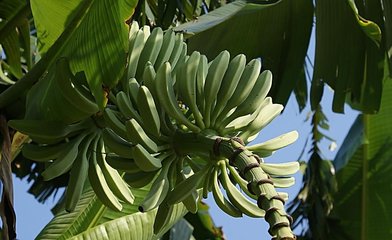Oh, hey, Squeaks, those bananas look delicious!
噢,嘿,吱吱,这些香蕉看起来很好吃!
I can't wait to bake banana bread.
我等不及要烤香蕉面包了。
But you're being kind of messy with your peels, buddy?
但老兄,你的香蕉皮到处乱扔!
We need to be careful, or somebody might slip and fall!
我们要小心些,否则有人可能会滑倒!
Whew. I'm okay, buddy. Sure, I'd love a banana.
呜呼。我还好,老兄。当然,我想要一根香蕉。
You know, bananas are a pretty special fruit.
你知道的,香蕉是一种相当特殊的水果。
Most of the fruit that we eat comes from seeds, which are kind of like a baby plant.
我们吃得大部分水果都来自种子,它们就像幼苗。
If they end up back in the ground, they can grow into the next generation of plants!
如果它们最终落到地面上,就能长成下一株植物!
But bananas don't have seeds! Or at least, not the bananas we eat.
但香蕉没有种子!或者至少,我们吃得香蕉没有种子。
Some wild bananas do have seeds, big seeds that make them hard to eat.
有些野生香蕉确实有种子,它们的大种子很硬,难以吃下去。
But the kind we grow on farms and buy in the store are almost always a type of banana called the Cavendish.
但我们在农场种植和在商店购买的香蕉几乎都是卡文迪什香蕉。
And Cavendish bananas don't grow seeds.
卡文迪什香蕉没有种子。
If you do see little black specks in your banana,
如果你确实在香蕉里看到了小黑点,
they're seeds that aren't fully formed, and they won't get big and tough.
它们是尚未完全成形的种子,它们不会变得又大又硬。
And that's not the only difference between bananas and other kinds of fruit.
这并不是香蕉和其他水果的唯一区别。
And the plant that we think of as a banana tree… isn't actually a tree!
还有我们认为的香蕉树,其实不是树!
It's a giant herbaceous plant, which is what we call a plant that doesn't have a woody stem.
它是一种高大的草本植物,我们把它叫做没有木质茎的植物。
Or, to put it another way: not a tree!
或者换种说法,它不是树!
Even though a banana plant looks like it has a trunk, that part is not a trunk at all.
虽然香蕉植株看起来有一个树干,但那部位根本不是树干。
It's actually made of leaves that are very tightly packed together.
它实际是由紧密叠合的叶鞘组成的。
They grow on top of each other, making the banana plant grow taller and taller, sometimes up to 7.5 meters high!
它们彼此叠加,让香蕉植株越来越高,有时能高达7.5米!
That's almost as tall as a two-floor house!
几乎有两层楼那么高!

Inside those packed leaves is the Rhizome.
这些叠加的叶鞘里面是根状茎。
It's a part of the banana plant that starts underground, growing a system of roots and shoots.
根状茎是从地下生长的香蕉植株的一部分,它长出根和芽系统。
And above ground, it grows taller and taller, inside the leaves of the fake stem.
在地上,它在叶鞘组成的假茎中越长越高。
When the banana plant is fully grown, the top of the rhizome grows clusters of flowers.
香蕉植株完全长大时,根状茎的顶端会长出一簇簇花。
Each cluster is called a hand.
每个花簇称为一个花穗。
And some of those hands of flowers will turn into hands of … delicious bananas!
有些花穗会变成美味的香蕉!
Together, all these hands of bananas are called a bunch.
所有这些香蕉花穗合在一起被称为一串。
There can be hundreds of bananas in just one bunch!
一串香蕉可以有几百个香蕉!
But remember, none of them have seeds.
但记住,它们没有种子。
So when it's time to grow brand new plants, banana growers have a different way of doing it.
所以,到种植全新植物的时候,香蕉种植者有不同的方法。
Instead of planting banana seeds, they cut away a part of the underground section of the rhizome, and plant that instead.
他们不种香蕉种子,而是把香蕉的地下茎割掉,种植起来。
Eventually, it grows into a new plant! But this can cause some problems.
最后,地下茎长成了一株新植物!但这仍会导致一些问题。
When plants grow from seeds, each one is a little bit different from the next.
当植物由种子长成时,每株植物会同下一代有点儿不同。
But all the Cavendish bananas in the world didn't come from seeds,
但是世界上所有的卡文迪什香蕉都不是来自种子,
they all came from each other's rhizomes!
它们都来自彼此的根状茎!
So each banana plant is an exact copy of the plant that came before it.
因此,每一株香蕉植株都是之前植株的完美复制品。
You know how sometimes it seems like almost everyone in your family, or in your school,
你知道有时候你的每位家人,或者学校里的每个人,
is getting sick with the same cold?
都会因同一种感冒生病吗?
Colds are contagious, which means you can catch them from someone else who's already sick.
感冒会传染,这意味着你可以从已经生病的人那里感染感冒。
Except, usually not everyone gets sick.
但也有例外,通常不是所有人都生病。
That's because each person is a little bit different from the next.
这是因为个体之间有些微的不同。
And a few lucky people might be resistant to the cold.
几个幸运的人可能能抵抗感冒。
Their bodies fight it off, so they don't feel sick, even when the rest of the class is home coughing and sneezing.
他们的身体抵抗住了感冒,所以他们不会生病,即使班上的其他人都因咳嗽和打喷嚏在家休息。
But unlike the kids in your school, bananas aren't all different from each other.
但与你学校里的孩子们不同,香蕉几乎都是相同的。
And plants can get sick, just like people and animals do.
而且植物也会生病,就像人和动物一样。
So if a disease comes along that makes one Cavendish banana sick …
所以如果一种疾病出现,使一株卡文迪什香蕉生病时,
it can make every other Cavendish banana in the world sick, too.
它也能使世界上其他的卡文迪什香蕉生病。
It's actually happened once before, with a different type of banana.
这在以前发生过一次,发生在另一种香蕉身上。
Years ago, most people weren't eating Cavendish bananas.
多年以前,大部分人不吃卡文迪什香蕉。
Instead, they ate a type of banana called the Gros Michel.
他们吃的是大麦克香蕉。
People say it was even tastier than the Cavendish bananas we eat today!
人们说它甚至比我们今天吃得卡文迪什香蕉还要美味!
But more than 60 years ago, a sickness called Panama disease hit the Gros Michel banana plants
但在60多年前,一种巴拿马病袭击了大麦克香蕉植株,
and wiped almost all of them out.
并让它们几乎全部消失了。
Luckily for us, the Cavendish banana was resistant to it, and didn't get sick.
对我们来说幸运的是,卡文迪什香蕉对它有抵抗力,而且没有生病。
So banana growers started growing Cavendish bananas instead.
于是香蕉种植者开始种植卡文迪什香蕉。
But we might not have Cavendish bananas forever.
但我们可能不会永远都能吃到卡文迪什香蕉。
There are two different diseases threatening them, which have begun to spread around the world.
有两种不同的疾病威胁着它们,并且已经开始在世界各地传播了。
And banana growers and scientists don't want to let them kill off all the bananas on farms!
香蕉种植者们和科学家不想让它们杀死农场里的所有香蕉!
So they're in a big hurry to find better ways to grow healthy bananas,
所以他们急于找到更好的方法来种植健康的香蕉,
and to help develop new kinds of bananas that won't get sick from the new diseases.
并帮助开发不会因新疾病而生病的香蕉新品种。
The key to that may be to go back to wild bananas, the kind with the big, tough seeds.
要做到这一点,关键可能要回到野生香蕉,即那种有又大又硬种子的香蕉身上。
One great way to stop future diseases would be to create new types of bananas with more diversity.
阻止未来疾病发生的一个好办法是生产种类更丰富的新型香蕉。
That means a group where each plant is a little bit different.
这意味着每株植物都有一点儿不同。
This way, even if there's a new banana disease, not all of the plants will get sick.
这样的话,即使出现新的香蕉病,也不是让所有植株都生病。
When we aren't all exactly alike, things just work better!
当我们不完全相同时,事情就会变得更好!
Like me and Squeaks. We're both different, but we make a great team …
就像我和吱吱一样,我们完全不同,但我们是个很优秀的团队...
and we're both just bananas about bananas!
我们都对香蕉着迷!
Thanks for joining us!
感谢您的收看!
If you want to keep learning and having fun with Squeaks and me, hit the subscribe button,
如果你想继续学习,与我和吱吱共度美好时光,就点击订阅吧,
and don't forget to check us out on the YouTube Kids app.
不要忘了在YouTube Kids app关注我们呦!
Thanks! We'll see you next time, here at the Fort!
感谢您的收看!我们下期见,沃斯堡等你哦!


